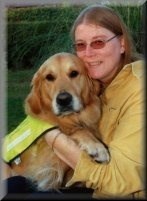It seems clear to me that it is little wonder that the general public are confused about assistance dog access sometimes. We're a generation who have been brought up collecting bottle tops for Guide Dogs but things have moved on. The law now clearly states that any person with a disability accompanied by an assistance dog trained to mitigate their disability should be treated equally.
So, it goes without saying, that shops would want to welcome all assistance dog partnerships doesn't it? Yeh, right! Literally, within five minutes in a town centre (Windsor) recently, we saw four different "welcome" or "not welcome" signs.

Come on Waitrose, you can do better than that, surely?

Lots of information on show at Starbucks, but no generic sign for assistance dogs!

Brilliant! Well done The King & Castle!

... and well done to Boots too!




8 comments:
It's amazing those stores can get away with that, would they really turn you away even though Caesar is not a seeing eye dog?
Most people don't realize that Guide Dogs are not the only type of Service Dog that exists in the world because they've simply never been taught about the things these dogs do and/or have never been interested.
In my area, the sign I see most commonly is "Service Dogs Only" which includes any type of service animal. That works for me. :)
The dumbest sign I've seen was at a thrift store in the DC area: "No pets allowed except Seeing Eye dogs." There's just so much wrong with that one, I don't know where to start.
Lvdogs98 - legally, NO business can turn away a service dog (regardless of what kind of service dog it is and what kind of disability the person has), no matter what their sign says. That's not to say they don't try / aren't ignorant about it, but the ADA (Americans with Disabilities Act) says they can't.
lvdogs98, thanks for your question.
Mauser*girl is correct in many respects, they cannot refuse. The applicable law in the UK, which is where we are, is the Disablity Discrimination Act of 1995 (DDA) and subsequent revisions.
What I find is that some of the places that display the guide dogs only signs will in fact refuse other types of assistance dogs, this is usually due to ignorance of the law, backed up by the sign they are displaying.
However, even if not turned away, personally, I find it to be unwelcoming and uninclusive.
All the assistance dogs are equal in the eyes of the law, but some get an easier passage than others in reality.
It's an education thing, and certainly has got better in recent years, but there's still a way to go.
I've had experience working my guide dog in a regular guide dog harness that said "Guide Dogs for the Blind" on it while I was walking, and since becomming a quadriplegic working the same guide dog only from a wheelchair with a non guide dog harness. To be honest, I've had the same amount of issues when it comes to access in both cases. Even when my dog was clearly in a guide dog harness and guiding me, people still said "dogs are not allowed in here" and said they "didn't know she was a guide dog". It doesn't make a difference what is on the signs, or even if there are signs at all.
They should say "guide AND service animals allowed" if there is a sign, but I think it's better for companies to just better educate their employees. Then we wouldn't need signs or anything.
Hi Kim, thanks for visiting :) Here in the UK we only have dogs that assist people so service animals wouldn't apply. Also, even the term "service dog" here means something quite different. I'll try and post a pcture tomorrow.
I personally think "assistance dogs only" would be the best thing, when it says guide and other ... it gives the impression that the other assistance dogs are second to the guides and in fact they are all equal in th eeyes of the law. It's an uphill battle though!
Oh, well if it said "assistance and guide dogs only" then. It doesn't matter what order it is in. People think of guide dogs and assistance dogs as totally different. If it just said "assistance dogs" then people would have a problem with allowing guide dogs. I think sometimes having signs and things just cause way moreproblems than anything else. The concentration should be on education, and forget about signs.
I think it would be difficult to educate without signs Kim. Assistance dog is a generic term and it includes guide dogs. The only reason they have remained separated for so long is that it is a marketing issue! However it is no coincidence that it reinforces in the minds of the general public that they are somehow different or better when in fact they are not.
To convince the public of equality of all the dogs that assist people with disabilities we need one generic term.
The funny thing is that I've seen a "Seeing Eye dogs only" sign in the DC area too...at Gallaudet University. It's when you enter the basement of Ely Center, with the sign that says "Gallaudet Bookstore Entrance" - that entrance is barely used anymore, and I think they've completely forgotten about it. I haven't heard that they're planning to remove the Bookstore Entrance sign (it hasn't been located there in many years) or change the Seeing Eye sign.
But what's really funny is that there are dogs all over Gallaudet! A great many are just pets, and Gallaudet is working to establish new policies about dogs, but there are definitely dogs everywhere, and a few legitimate hearing dogs. I've seen one or two guide dogs as well, for deafblind people.
Post a Comment